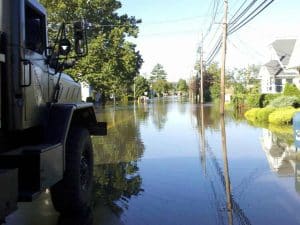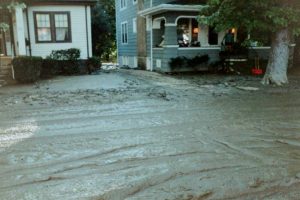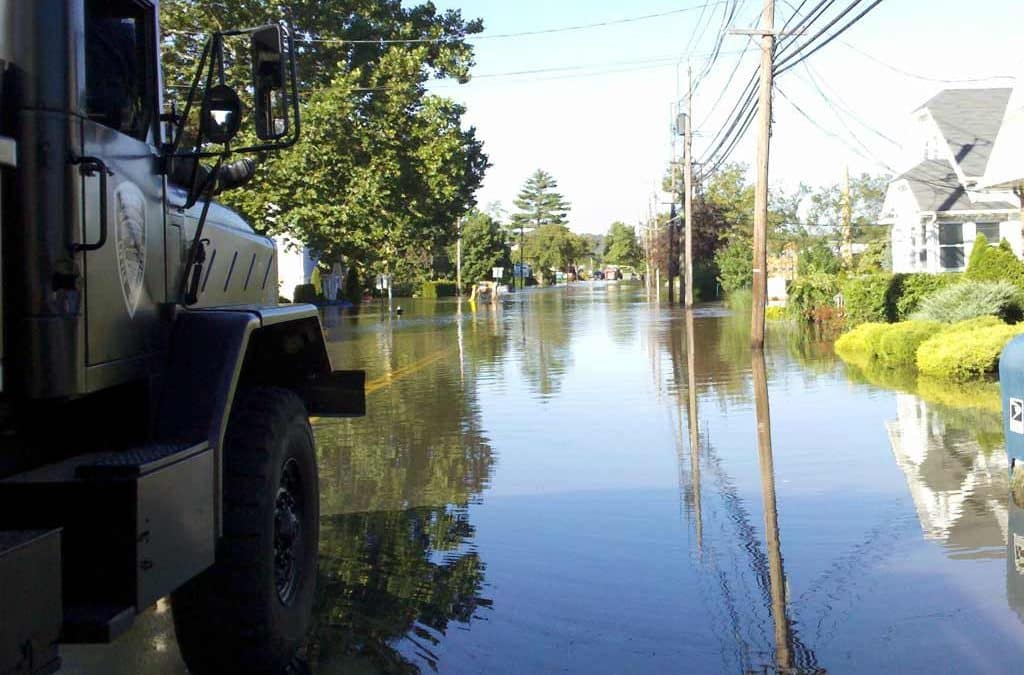
Each year, flooding accounts for billions of dollars in losses in the United States, making it one of the most expensive and destructive natural disasters. In Oregon and beyond, water damage restoration companies know these watery catastrophes spare no one, leaving behind a trail of extensive property damage and personal heartbreak. Lack of knowledge is not an option when protecting your Portland home from this dangerous threat. This guide by SureBuild Restoration, the leading expert for water damage restoration in Portland, will equip you with the crucial knowledge and practical strategies required to help your home against the destructive force of floods.
Flood damage refers to the devastating aftermath of an overflow of water that submerges land and property. In the context of homes, it can lead to severe structural damage, including the weakening of foundations and the corrosion of structural home materials. It also triggers a host of secondary issues like mold growth and contamination. The impact extends beyond property damage, causing financial setbacks and emotional distress. The power of water should not be underestimated: even a single inch of floodwater can result in damages upwards of $25,000. Understanding this threat is the first step toward implementing effective preventative measures.
The importance of proactive measures to prevent flood damage cannot be overstated. With flood damage, prevention is always better—and often cheaper—than extensive water damage restoration. In Portland, a well-prepared home can help withstand the onslaught of floodwaters, significantly reducing potential damage and the associated flood damage restoration costs. Prevention measures such as sealing basements, elevating critical utilities, and installing flood barriers can make an enormous difference, potentially saving thousands of dollars in damages. Furthermore, these preventative steps do more than shield physical property—they safeguard peace of mind. Knowing your home is equipped to stand against floodwaters can instill a sense of security and reduce the distress accompanying flood warnings. Therefore, investing in flood damage prevention is not merely a financial decision but a commitment to protecting your home and well-being from the unpredictable force of nature.
Understanding Flood Risks
To effectively safeguard your home in Portland against flooding, it is crucial to understand the different types of floods and their respective causes.
Types of Flooding
There are several types of flooding, each with distinct causes and risk factors.
Riverine floods, or river floods, occur when excessive rain from storms or snowmelt causes rivers, streams, or lakes to overflow their banks. This type of flood is common in regions with significant annual precipitation or rapid snowmelt. Recently, weather changes have also increased the chances of river flooding, leaving you with flooding and storm damage.
Coastal floods result from extreme tidal phenomena, often exacerbated by storm surges or tsunamis. In other words, these floods are the product of specific weather or seismic events causing the sea level to rise and flood coastal areas.
Flash floods are sudden, rapid floods typically caused by intense rainfall over a short period in a specific locale. Often occurring with little warning, they are particularly dangerous due to the swift and powerful nature of the floodwaters.
Each type of flood has unique triggers and impacts, necessitating tailored prevention and specific strategies for water damage restoration. Portland residents must understand the flood risks specific to their location, so they can take the most effective measures to protect their homes.
Understanding Flood Zones
A critical aspect of understanding flood risks in Oregon involves familiarizing yourself with flood zone maps available from FEMA. Flood zones are geographical areas determined by the Federal Emergency Management Agency (FEMA) as per their level of risk for flooding. These zones are depicted on a community’s Flood Insurance Rate Map (FIRM) or flood hazard boundary map. Each zone reflects the severity and frequency of flooding in that area.
Flood zones are classified into different categories. For instance, according to FEMA, Zone A has a 1% annual chance of flooding and a 26% chance over the life of a 30-year mortgage. On the other hand, Zone X represents areas with minimal risk of flooding.
Knowing your flood zone is paramount as it informs you about the likelihood of a flood event and impacts insurance premiums and mitigation strategies. If you live in a high-risk flood zone, taking necessary preventive measures and maintaining adequate flood insurance are key to protecting your home from potential flood damage. You can find your flood zone by checking the FEMA’s Flood Map Service Center or consulting with your local city planning or zoning department.
Identifying Flood-Prone Areas and Assessing Personal Flood Risk
Identifying flood-prone areas and assessing your risk is essential for effective flood preparedness. Several factors can indicate whether an area is prone to flooding:
Geography and Topography: Low-lying areas near bodies of water are generally more susceptible to flooding. Similarly, areas with steep slopes can experience rapid runoff during heavy rain, leading to potential flooding.
Drainage Systems: Areas with poor or inadequate drainage systems are more likely to experience flooding during periods of heavy rainfall.
Erosion Patterns: Over time, erosion can change the landscape and create areas more prone to flooding.
Climate and Rainfall: Regions with high annual rainfall or prone to storms and hurricanes have an increased risk of flooding.
To assess your flood risk, consider the following:
Proximity to Water Sources: Living near a river, lake, or coast increases your risk of flooding.
Flood History: If your area or property has experienced flooding in the past, it’s more likely to happen again.
Flood Zone: As discussed earlier, your FEMA-designated flood zone can significantly inform your flood risk assessment.
Local Climate Trends: Increasing instances of heavy rain or storms in your area might elevate the risk of flooding.
Understanding these factors and assessing your risk is the first step in preparing an effective flood protection plan. Stay informed about your local climate trends, flood history, and drainage systems. Regularly consult updated FEMA flood zone maps. Reaching out to experts in flood and water damage restoration in Portland can also give you expert insights into trends for your area. You can significantly reduce flood risk and potential damage by staying vigilant and being proactive.
Flood Prevention Strategies
Structural Mitigation Measures
One effective way of preventing flood damage is through structural mitigation measures. These are physical modifications to buildings or the environment to reduce or prevent flood damage.
Elevating homes above flood levels can significantly reduce the risk of water intrusion. This can be achieved by raising the entire structure or constructing a new upper floor for living spaces.
Installing flood barriers like floodwalls or levees can prevent floodwaters from reaching your property.
Improving drainage systems is also an essential structural measure. Adequate drainage can efficiently channel water away from your property, preventing accumulation that could lead to flooding. These alterations require an initial investment but can save substantial costs in the long run by mitigating the loss and damage caused by floods.
Non-Structural Mitigation Measures
In addition to physical modifications, non-structural mitigation measures protect against flood damage.
Purchasing flood insurance for homeowners is a vital non-structural measure that can cover repairing or replacing property damaged by floods. Given that most homeowner’s insurance policies do not cover flood damage, obtaining a separate flood insurance policy becomes extremely important, especially for high-risk flood zones. The National Flood Insurance Program is available in participating communities.
Developing emergency plans can significantly enhance safety during a flood event. Such plans often include evacuation routes, communication strategies, and procedures for shutting off utilities.
Storing valuables in safe locations, preferably on upper floors or in waterproof containers, to protect them from flood damage is another practical non-structural measure.
Maintenance and Inspection of Flood Prevention Systems
Regular maintenance and inspections of flood prevention systems are crucial to ensure they function effectively when you need them the most. Over time, structural components such as walls, floodgates, or drainage systems can deteriorate or become obstructed. Regular checks and timely repairs can ensure these systems work optimally during flood events. Similarly, flood barriers should be inspected for integrity, and the land around them should be checked for erosion or other potential issues. Also, reevaluating your insurance coverage, emergency plans, and storage solutions can ensure they remain adequate and relevant. Regular maintenance and inspections are as important as the prevention systems themselves, ensuring they provide the best protection against potential flood damage.
Preparing for Flood Emergencies
Floods may not be something that you have control over, or
Preparing for a Flood Emergency: A Step-by-Step Guide
Preparing for a flood emergency involves three primary steps: creating an emergency plan, assembling a flood kit, and securing valuables.
Creating an Emergency Plan
Begin by identifying safe areas in your home that are elevated and flood-free. Everyone in your household should know where to go in case of a sudden flood event. Determine escape routes and safe meeting places outside your home. Everyone should know multiple ways to exit your home and the fastest route to higher ground. Include provisions for pets and family members with special needs.
Assembling a Flood Kit
Prepare a flood kit that includes enough essentials for at least 3 days:
- At least a gallon of drinking water per person per day
- Non-perishable foods such as dried fruit, peanut butter, or energy bars
- A battery-powered flashlight with a strong beam
- Batteries
- First-aid supplies such as bandages, antiseptic, gloves, and any prescribed medications, space blankets to keep warm till help arrives
- Documentation (like copies of important documents such as your insurance policy, copies of important government documents, and identification).
Having contact information for family members, a reputable company that specializes in water damage restoration in Portland and surrounding areas, and any other important numbers, such as doctors and your insurance company, is also suggested. When an emergency hits, the emotional toil and stress of a disaster make having access to the information you need immediately make this one less stressful thing to deal with. It’s important to ensure that your kit is easily accessible, portable, and waterproof. The size of your kit will be determined by how many people are in your family and their needs.
Securing Valuables
Store valuable items in the highest possible location or shift them to a safer place when a flood warning is in place. Place important documents and personal items like photographs in waterproof containers or digital backup.
Evacuating Safely During a Flood
 In a flood event, your safety and your family’s is your primary concern. Identify potential evacuation routes that lead to higher, safe grounds. Consider any routes that could be cut off by additional flooding, and plan accordingly. Be aware of the location and route to your nearest emergency shelter. Always follow the directions from local authorities, and never ignore an evacuation order. Your home can be rebuilt, items can be replaced, and water damage restoration for Portland homeowners can return your flooded home to practically new once the danger has passed and recovery begins.
In a flood event, your safety and your family’s is your primary concern. Identify potential evacuation routes that lead to higher, safe grounds. Consider any routes that could be cut off by additional flooding, and plan accordingly. Be aware of the location and route to your nearest emergency shelter. Always follow the directions from local authorities, and never ignore an evacuation order. Your home can be rebuilt, items can be replaced, and water damage restoration for Portland homeowners can return your flooded home to practically new once the danger has passed and recovery begins.
Staying Informed About Flood Warnings
Stay vigilant about the local weather updates and flood warnings. Subscribe to local emergency notification systems and promptly follow local authorities’ instructions. Remember, a flood watch means a flood is possible in your area, while a flood warning signifies that flooding is already occurring or will soon occur. Understanding these distinctions can help you respond appropriately and ensure your safety.
Regularly preparing and staying updated about weather conditions and flood warnings can significantly reduce the risk of personal harm and property damage.
Flood Aftermath, Recovery, and Water Damage Restoration
Initial Steps Following a Flood
Immediately following a flood, ensuring safety and assessing water damage is critical. When starting the initial steps of water damage restoration, Portland residents should keep the following in mind:
Safety is paramount: avoid entering your home until local officials have declared it safe. Floodwaters can cause structural damage, making your property unstable. Moreover, the water may be contaminated with sewage or other hazardous substances. Once you receive the go-ahead, wear protective clothing, such as rubber boots and gloves, before moving in.
Contact your insurance provider promptly to report the damage. Most policies require you to notify your provider within a certain time, so don’t delay. Provide an accurate account of the damage, including photos or videos.
Assessing the damage is a crucial step. Document everything affected by the flood, including structural damage, damaged personal items, and any lost items. This information is necessary for your insurance claim and will help guide your recovery efforts. A professional water damage restoration company can assist you with getting a proper assessment for your insurance company.
Flood Restoration and Cleanup Procedures
Cleanup after a flood should be thorough to prevent further damage and possible health risks. While smaller flood damage can be a DIY project, getting professional help for bigger clean-ups is highly recommended.
Remove standing water as soon as possible. You can use pumps, wet/dry vacuums, or buckets. Remember, standing water can lead to mold growth, which harms your health.
Disinfect all affected areas once the water is removed to kill bacteria and other harmful organisms that may have been in the flood water. Household bleach is one commonly used disinfectant.
Handling contaminated materials appropriately is crucial for your safety and the effectiveness of the cleanup. Wear protective clothing and follow local guidelines for disposing of flood-damaged items.
Seeking Professional Assistance
Major repairs and water damage repair work after flood damage are typically complex and should be handled by professionals. These experts in flood damage restoration have the necessary tools, knowledge, and experience to safely restore your property to its pre-flood condition. Whether repairing structural damage, replacing electrical systems, treating mold growth, or other water damage restoration, Portland residents can ensure tasks are done correctly and safely. This helps you get back to normal faster and reduces the risk of future problems related to flood damage. Remember, while the upfront cost may seem high, hiring professionals can save you money in the long run by avoiding additional repairs or complications in the future. In addition to repairs, as previously mentioned, your contractor can assist in evaluating the damage and assisting in filing a claim with your insurance company, making your claim more accurate and quicker to file.
Wrap Up
In conclusion, the significance of comprehensive flood prevention measures and preparedness cannot be overstated. These actions are crucial in mitigating potential flood damage and ensuring a swift recovery. Every step, from creating an emergency plan and assembling a flood kit to securing valuables, is critical to safeguarding your home and loved ones. Regularly maintaining these measures and staying informed on local flood warnings prove invaluable during unexpected flood events. We strongly encourage you to take these steps and prepare. For further information and resources, feel free to reach out to professionals, and if you’re in Portland and need assistance with flood water damage restoration, don’t hesitate. Act now to protect your home. Contact SureBuild Restoration today – your trusted partner in water damage restoration.

